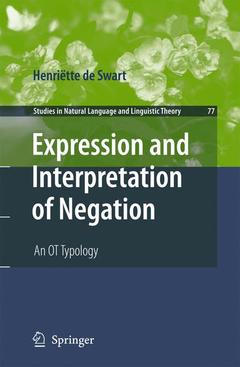Expression and Interpretation of Negation, 2010 An OT Typology Studies in Natural Language and Linguistic Theory Series, Vol. 77
Auteur : de Swart Henriëtte

Unique in its combination of syntactic and semantic formalization in the analysis developed, and wide empirical coverage of data
Valuable in its development of bi-directional Optimality Theory as an empirically viable theory of grammar, and a typology of the syntax-semantics interface
Distinctively combines a surface-oriented syntax with a fully compositional semantics
Offers the most refined analysis so far of instances of double negation in negative concord languages
Date de parution : 05-2012
Ouvrage de 279 p.
15.5x23.5 cm
Disponible chez l'éditeur (délai d'approvisionnement : 15 jours).
Prix indicatif 105,49 €
Ajouter au panierDate de parution : 12-2009
Ouvrage de 279 p.
15.5x23.5 cm
Thème d’Expression and Interpretation of Negation :
Mots-clés :
Cognitive; Cross-linguistic; Jespersen cycle; Semantics; Syntax; Typology; diachron; semantic



